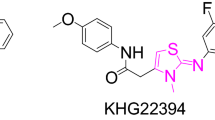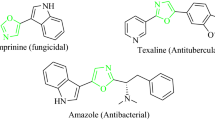Abstract
A series of 2-oxazolines were synthesized using a simple, one-pot method under inert, moisture-free conditions from the benzoylacetonitrile and β-aminoalcohols mediated by 115–172 mol% ZnCl2. Structures of products were fully characterized by NMR, IR and MS.

A series of 2-oxazolines were synthesized from the benzoylacetonitrile and β-aminoalcohols using a simple, one-pot method, mediated by 115–172 mol% ZnCl2, under inert moisture-free conditions. The chemical structures of the products were fully characterized using NMR, IR and MS analyses.
Similar content being viewed by others

Avoid common mistakes on your manuscript.
1 Introduction
2-Oxazolines and their organometallic complexes were used as catalysts in organic reactions and polymerizations.[1] The reported methods for synthesis of 2-oxazolines include the following: direct condensation- cyclodehydration of carboxylic acids with amino alcohols;[2] mediation by N, N’-diisopropylcarbodiimide;[3] use of aldehydes, amino alcohols, or N-bromosuccinimide as an oxidizing agent;[4] reaction of nitriles with β-amino alcohols under thermal, ultrasonic or microwave irradiation using InCl3 as a catalyst;[5] and tungstophosphoric acid-catalyzed formation.[6] The one-pot synthesis is characterized by mild reaction conditions, broad scope, high yields and preparative simplicity. Encouraged by the pioneering work, we wish to report the novel methodology for the synthesis of 2-oxazolines from the benzoylacetonitrile and β-aminoalcohols using harsh reaction conditions (115–172 mol% ZnCl2).
2 Experimental
Benzoylacetonitrile and amino alcohol were purchased from Acros, Aldrich, Fluka. Flash column chromatography was performed using E. Merck silica gel (60, particle size 0.02–0.03 mm), 1H and 13C NMR and 31P NMR spectra were obtained using Bruker AM-500 spectrometer. Proton chemical shifts are reported in ppm (δ) with the solvent relative to tetramethylsilane (TMS) employed as the internal standard (CDCl3,δ 7.26 ppm). The following abbreviations were used to designate chemical shift mutiplicities: s = singlet, d = doublet, t = triplet, m = multiplet. Infrared spectra were recorded on a Mattson Galaxy Series FTIR 3000 spectrometer; peaks are reported in cm−1. Elemental analysis were obtained on Elemental Analyzer AE-3000, High resolution mass spectra (HRMS) were obtained on Micro GCT-MS equipped with an EI ion source. Optical rotations were measured on WZZ-1 automatic polarimeter with a 2 cm cell at the sodium D-line.
2.1 Structure determination
The yellow prismatic crystal of the intermediate 3a of approximately 0.156 x 0.132 x 0.034 mm was selected for the data collection on a ‘graphite’ diffractometer with mirror monochromated MoK /α radiation (λ = 0.71073Å). A total of 4911 reflections were collected in the range of 2.29 <𝜃 < 25.99° by using ‘phi and omega scans’ techniques at 293(2) K, C15 H 20 N 2O , M = 244.33, monoclinic, C 2, a = 8.794(4)Å, α = 90°, b = 9.092(4) Å, β = 113.290(7)°, c = 9.686(5) Å, γ = 90°, V = 711.3(6)Å3, Z = 2, Dcalc.= 1.141mg/m 3, the final R factor was R1= 0.0633, 2770 for reflections with I 0> 2 σ(I 0), Rω= 0.639 for all data. The structure were solved by full-matrix least-squares on F2 using the SHELXTL PROGREM.[7,8]
The yellow prismatic crystal of the intermediate 5c of approximately 0.28x 0.08 x 0.04 mm was selected for the data collection on a ‘graphite’ diffractometer with mirror monochromated Mo K /α radiation (λ = 0.71073Å). A total of 4194 reflections were collected in the range of 0.9969 <𝜃 < 0.9784° by using ‘phi and omega scans’ techniques at 293(2) K, C15 H 13 NO, M = 223.26, monoclinic, P2(1), a = 10.235(4)Å, α = 90 °, b = 5.846(2) Å, β = 110.355(6)°, c = 10.614(4) Å, γ = 90°, V = 595.3(4)Å 3, Z = 2, Dcalc.= 1.245mg/m 3, the final R factor was R1= 0.0302, 2280 for reflections with I 0>2σ(I 0), Rω= 0.0485 for all data. The structure were solved by full-matrix least-squares on F 2 using the SHELXTL PROGREM.[7,8]
2.2 The synthesis of (4R/S)-4,5-dihydro-4-(R group)-2- phenyloxazole (4a–4b and 5c–5d)
Dry ZnCl2(8.29–12.41mmol) benzoylacetonitrile (1.0 g) and L-amino alcohol (4.2–4.8g) were combined under anhydrous and oxygen-free conditions in a dry 100 mL Schlenk flask. The reagents were dissolved in 50 mL of dry chlorobenzene and the reaction mixture was refluxed for 72 h. The solvent was removed under reduced pressure, and the resulting residue was dissolved in 15 mL H2O, extracted with dichloromethane (20 x 3 mL). The solvent was removed under vacuum to afford crude red oil. Further purification was achieved using silica gel (petroleum ether/dichlormethane 3/7). The solvent was slowly evaporated from the last fraction collected to yield colourless crystals.
2.2.1 (4a)
The same procedure as described 2.2. The colourless crystals, M.p. 108–112°C, yield: 65%; [a]\(^{5}_{\mathrm {D}}=-80.0^{\circ }\)(c = 0.23, CH2Cl2): 1H NMR (600MHz, CDCl3, 27°C), δ (ppm) = 7.92 (d, J = 6.6Hz, 2H), 7.37 ∼7.44(m, 3H), 4.46 ∼4.49(m, 1H), 4.30 ∼4.32(m, 1H), 3.97 (t, J = 0.6Hz, 1H), 1.78 ∼1.83(m, 1H), 1.68 ∼1.72(m, 1H), 1.34 ∼1.39(m, 1H), 0.95 ∼0.97(dd, J = 6.6Hz, 6.6Hz, 6H), 13C NMR(150MHz, CDCl3, 27°C) 163.2, 131.1(x2), 128.2 (x4),73.1, 65.1, 45.6, 25.5, 22.9, 22.7; IR (KBr), cm −1: 3435, 3062, 2957, 2927, 2870, 1652, 1580, 1495, 1468, 1450, 1358, 1327, 1310, 1276, 1174, 1079, 1063, 1026, 1195, 972, 945, 779, 695; HRMS(EI):m/z (%): calcd for C13 H 17NO: 203.1310; found: 203.1299.
2.2.2 (4b)
The same procedure as described 2.2. The colourless crystals, yield: 68%; M.p. 98–102°C [a]\(^{5}_{\mathrm {D } }= -65.7^{\circ }\)(c =0.024, CH2Cl2): 1H NMR (600MHz, CDCl3, 27°C), δ (ppm) = 7.98 (d, J = 6Hz ∼2H), 7.40 ∼7.46 (m, 3H), 4.40 ∼4.41 (m, 1H), 4.10–4.14 (m, 2H), 1.85–1.88(m, 1H), 0.93 ∼1.05 (dd, J = 5.5Hz, 5.5Hz, 6H), 13C NMR(150MHz, CDCl3, 27°C) 163.2, 131.1(x2), 128.1(x4), 72.5, 69.9, 32.7, 18.8, 18.0.; IR (KBr) cm −1: 2959, 2930, 2898, 2873, 1652, 1580, 1495, 1467, 1450, 1385, 1354, 1318, 1305, 1286, 1081, 1065, 1026, 968, 904, 780, 694; HRMS(EI):m/z (%): calcd for C12 H 15NO: 189.1154; found: 189.1152.
2.2.3 (5c)
The same procedure as described 2.2. The colourless crystals, yield: 70%; M.p. 134–138°C, [a]\(^{5}_{\mathrm {D}}=+\)27.7 °(c = 0.087, CH2Cl2): 1H NMR (500MHz, CDCl3, 27°C), δ (ppm) = 8.14 (d, J =5.5Hz, 2H), 7.34 ∼7.55 (m, 8H), 5.43 ∼5.44(m, 1H), 4.80 ∼4.82 (m, 1H), 4.29 ∼4.32(m, 1H); 13C NMR(125MHz, CDCl3, 27°C) 164.7, 142.4, 131.6(x2), 128.8(x2) 128.5(x2), 128.4(x2), 127.6(x2), 126.8, 74.9, 70.2; IR (KBr) cm −1:, 3062, 3030, 2965, 2898, 1647, 1603, 1580, 1495, 1473, 1450, 1357, 1354, 1317, 1300, 1277, 1246, 1084, 1066, 1025, 974, 952, 894, 780, 760, 696, 678, 539; HRMS(EI): m/z (%): calcd for C15 H 13NO: 223.0997; found: 223.0994.
2.2.4 (5d)
The same procedure as described 2.2. The colourless crystals, yield: 72%, M.p. 140–144°C [a]\(^{5}_{\mathrm {D}}= +36.2^{\circ }\)(c = 0.30, CH2Cl2): 1H NMR (500MHz, CDCl3, 27°C), δ (ppm) = 8.0 (t, J = 0.6Hz, 2H), 7.23 ∼7.48 (m, 7H), 4.56 ∼4.61(m, 1H), 4.32 (t,1H), 4.13(t, J = 0.6Hz, 1H); 3.24 ∼3.27(dd, J = 0.54Hz, 0.66Hz, 1H), 2.72 ∼2.76(dd, J = 0.64Hz, 0.8Hz, 2H), 13C NMR(125MHz, CDCl3, 27°C)163.7, 137.8, 131.2 129.1(x3) 128.4(x3),128.1(x2),126.3(x2), 71.6, 67.6, 41.6; IR(KBr) cm −1: 3061, 3028, 2924, 2897, 1651, 1603, 1580, 1495, 1451, 1357, 1281, 1084, 1060, 1025, 968, 780, 696, 678; HRMS(EI): m/z (%): calcd for C16 H 15NO: 237.1154; found: 237.1150.
2.3 (E)-[1(R)-Hydroxymethyl-3-methyl-butylimino]-3- phenyl-propionitrile (intermediate 3a)
1.2361g (9.09 mmol) of dry ZnCl2, benzoylacetonitrile 1.0057g (6.93 mmol) and L-Leucinol 4.7627 g were added under free-water and free-oxygen condition in a dry 100 mL Schlenk flask. They were dissolved in 50 mL of dry chlorobenzene, the reaction mixture was refluxed for 72 h. The solvent was removed under reduced pressure and the residue was dissolved in 15 mL H2O, extracted with 20 x 3 mL of dichloromethane, the solvent was removed under vacuum, gave the crude red oil. Further purification was performed by silica gel (petroleum ether/dichlormethane 3/7), then slowly evaporation from the collected last component to give a colourless crystals, yield: 40%; [a]\(^{20}_{\mathrm {D}}=\) -54.5 °(c = 0.011, CH3OH): 1H NMR (600MHz, CDCl3, 27°C), δ (ppm) = 7.43 ∼7.46 (m, 5H), 6.68 (d, J = 0.60Hz, 1H), 4.73 ∼4.74 (m, 1H), 4.14 (t, J = 1Hz, 1H), 3.30 (s, 1H), 2.47(t, J = 0Hz, 2H), 1.66 ∼1.68 (m, 1H), 1.36 ∼1.42 (m, 2H), 0.84 ∼1.32(m, 6H); 13C NMR (150MHz, CDCl3, 27°C) 157.1, 130.7, 124.3, 122.8 (x2), 122.7(x2), 117.1, 57.2, 52.0, 48.1, 19.0, 17.7(x2), 16.6; IR (KBr) cm −1: 3360, 3259, 3072, 2961, 2934, 2910, 2875, 2194, 1590, 1571, 1548, 1469, 1370, 1308, 1286, 1059, 1035, 777, 696, 659; HRMS(EI):m/z (%): calcd for C15 H 20 N 2O: 244.1576; found: 244.1572.
3 Results and Discussion
3.1 Synthesis
2-Oxazolines 4 and 5 were obtained in moderate yields (30–45%) using chlorobenzene under dry, anaerobic conditions. Our first goal was to obtain the novel oxazolinyl-zinc complexes when using a large amount of Lewis acid, and up to 140–172 mol% was used. The synthetic routes are shown in scheme 1.
On the basis of the results described above, the mechanism of formation of chiral compounds 4 and 5 can be proposed as nucleophilic attack onto ZnCl2-coordinated benzoylacetonitrile followed by cyclization and removal of acetonitrile group.
3.2 Structure
The crystal structures of 3a and 5c were obtained after isolation of the compounds from the solvent used for column chromatography, CH2Cl2/petroleum ether. C-N, C=N and C≡N bonds were undoubtedly formed [C-N 1.504(4) Å(3a), 1.455(4)Å(4b); C=N 1.357(4) Å (3a), 1.299 Å (4b); C≡N 1.152 Å (3a)], suggesting that 4 is an intermediate in the formation of 2-oxazolines (figures 1 and 2).
The crystal structure of the intermediate 3a. Selected bond length(Å): N(1)-C(7)1.357(4); N(1)-C(10) 1.455(4); N(2)-C(9)1.152(5); O(1)-C(11)1.423(4). Selected bond angels(° ):C(7)-N(1)-C(10)125.1(3); N(1)-C(7)-C(8) 123.2(3); N(1)-C(7)-C(6) 114.4(3); N(2)-C(9)-C(8)176.8(4); N(1)-C(10)-C(11)109.8(3); N(1)-C(10)-C(12)108.9(3).
4 Conclusions
We have shown that a large amount of ZnCl2 effectively promotes one-pot synthesis of oxazoline. This reaction is advantageous because it does not require a strong alkaline medium and uses the inexpensive catalyst ZnCl2.
Further studies are in progress to examine the scope of the one-pot synthesis of chiral organometallic complexes.
References
(a) Guo X Q and Schulz Rolf C 1994 Polym. Int. 34 229; (b) Ikeda S -I, Kondo H, Arii T and Odashima K 2002 Chem. Commun. 20 2422
Wipf P and Wang X D 2002 J. Comb. Chem. 4 656
Crosignani, S, Young Abigail C and Linclau B 2004 Tetrahedron. Lett. 45 9611
Schwekendiek K and Glorius F 2006 Synthesis 18 2996
Moghadam M, Mirkhani V, Tangestaninejad S, Mohammadpoor-Baltork I and Kargar H J 2009 Iran. Chem. Soc. 6 251
Mohammadpoor-Baltork I, Moghadam M, Tangestaninejad S, Mirkhani V and Hojati S F 2008 Catal. Commun. 9 1153
Sheldrick G M SHELXS-97 Program for X-ray Crystal Structure Solution Göttingen University: Germany 1997; Sheldrick G M SHELXL-97 Program for X-ray Crystal Structure Refinement Göttingen University: Germany 1997
Sout G H Jensen L H 1968 In X-ray Structure Determination: A Practical Guide (New York: MacMillan)
Acknowledgements
This work was supported by Hefei University of Technology. The authors acknowledge University of Science and Technology of China for providing the spectral measurements conditions.
Author information
Authors and Affiliations
Corresponding author
Additional information
Supplementary Information
Full experimental detail, 1H and 13C NMR spectra. This material can be found at www.ias.ac.in/chemsci. Crystallographic data for the structure 4c and 3a have been deposited in the Cambridge Crystallographic Data Centre, CCDC No. 957068-957069. Copies of this information may be obtained free of charge from the director, CCDC, 12 Union Road, Cambridge, CB2 1EZ, U.K. (fax: 44-1223336033, email: deposit@ccdc.cam.ac.uk or http://www.ccdc.cam.ac.uk).
Electronic supplementary material
Below is the link to the electronic supplementary material.
Rights and permissions
About this article
Cite this article
LUO, M., ZHANG, J.C. & YIN, H. Efficient one-pot synthesis of 2-oxazolines from benzoylacetonitrile and β-aminoalcohols mediated by ZnCl2 . J Chem Sci 127, 163–166 (2015). https://doi.org/10.1007/s12039-014-0761-2
Received:
Revised:
Accepted:
Published:
Issue Date:
DOI: https://doi.org/10.1007/s12039-014-0761-2






